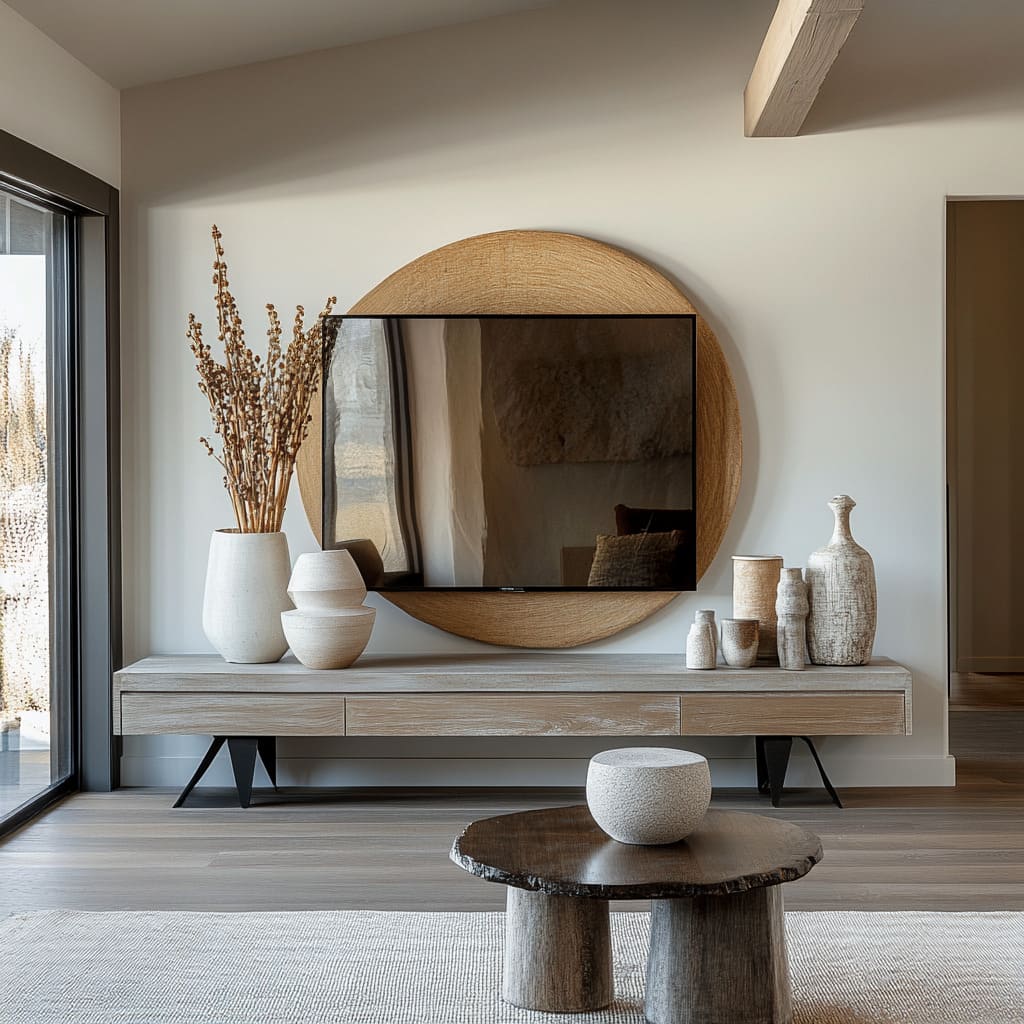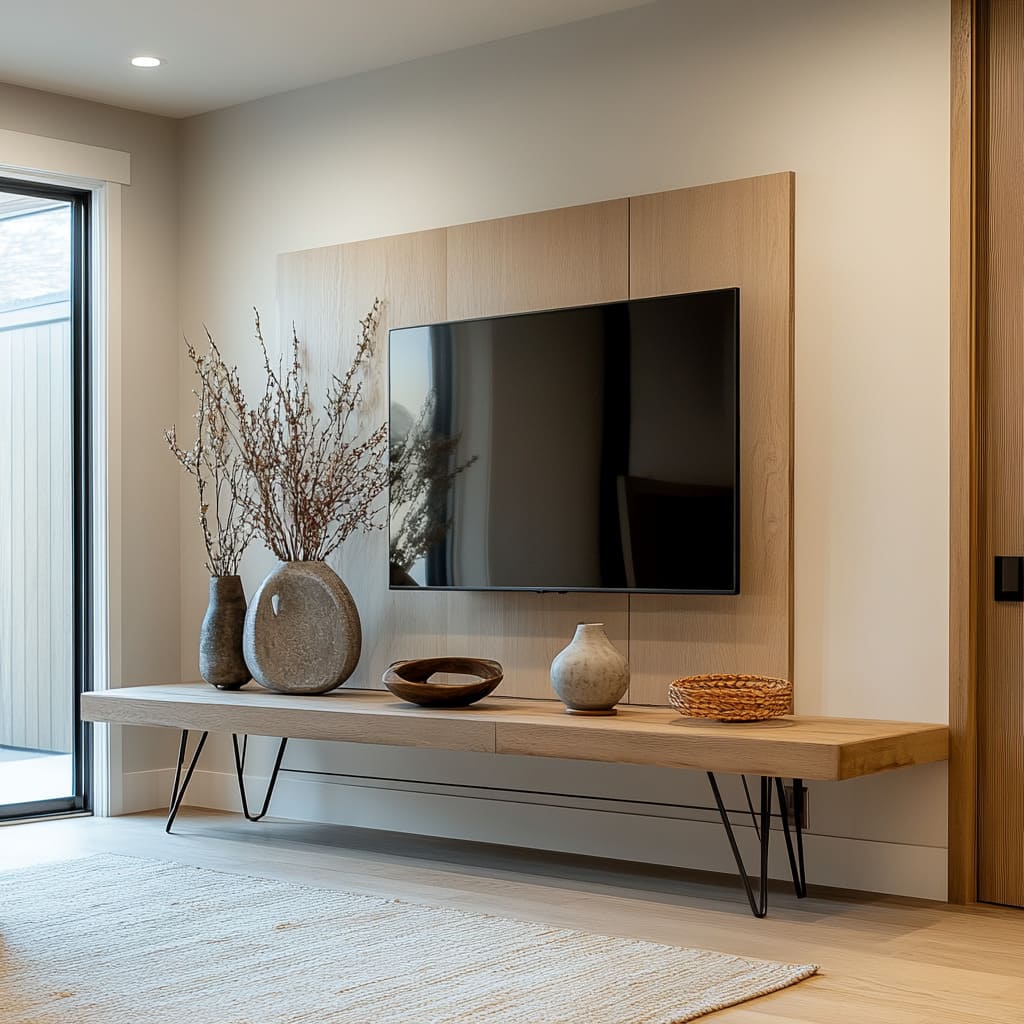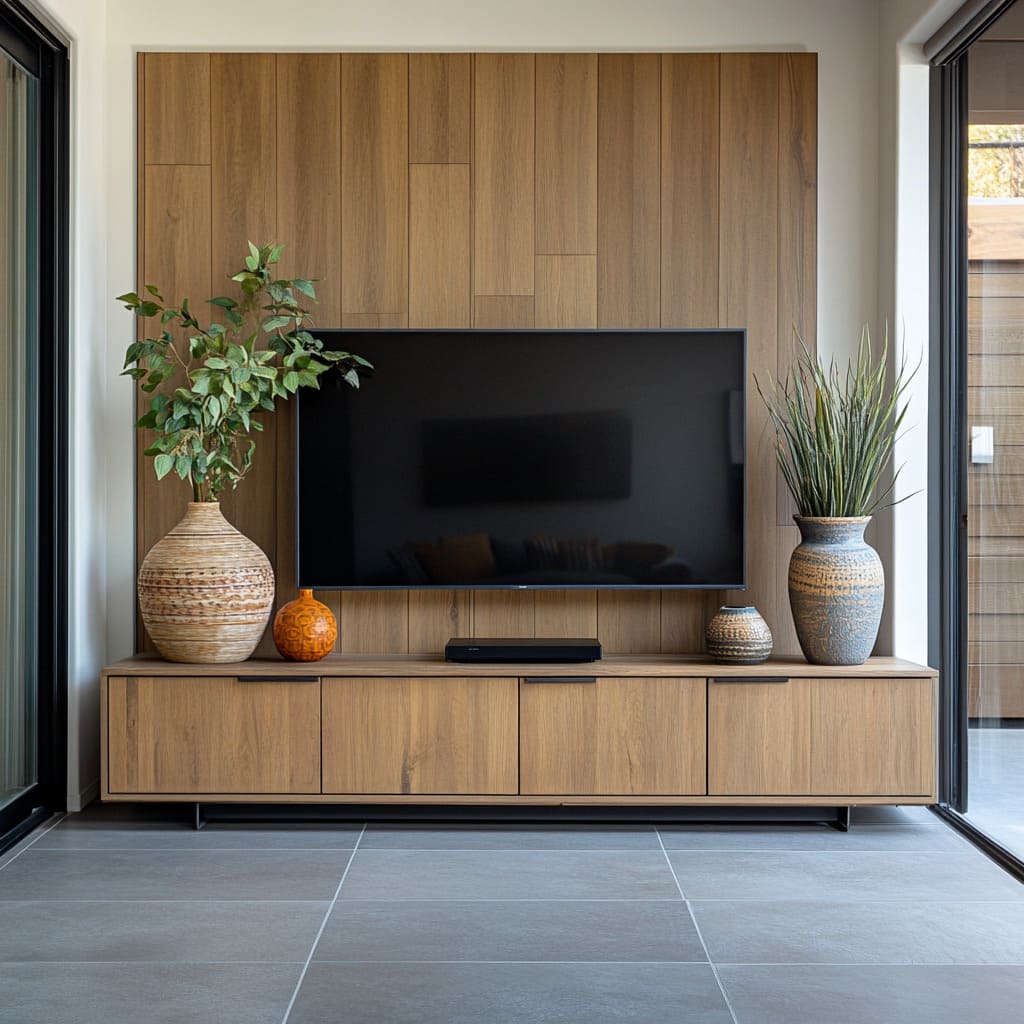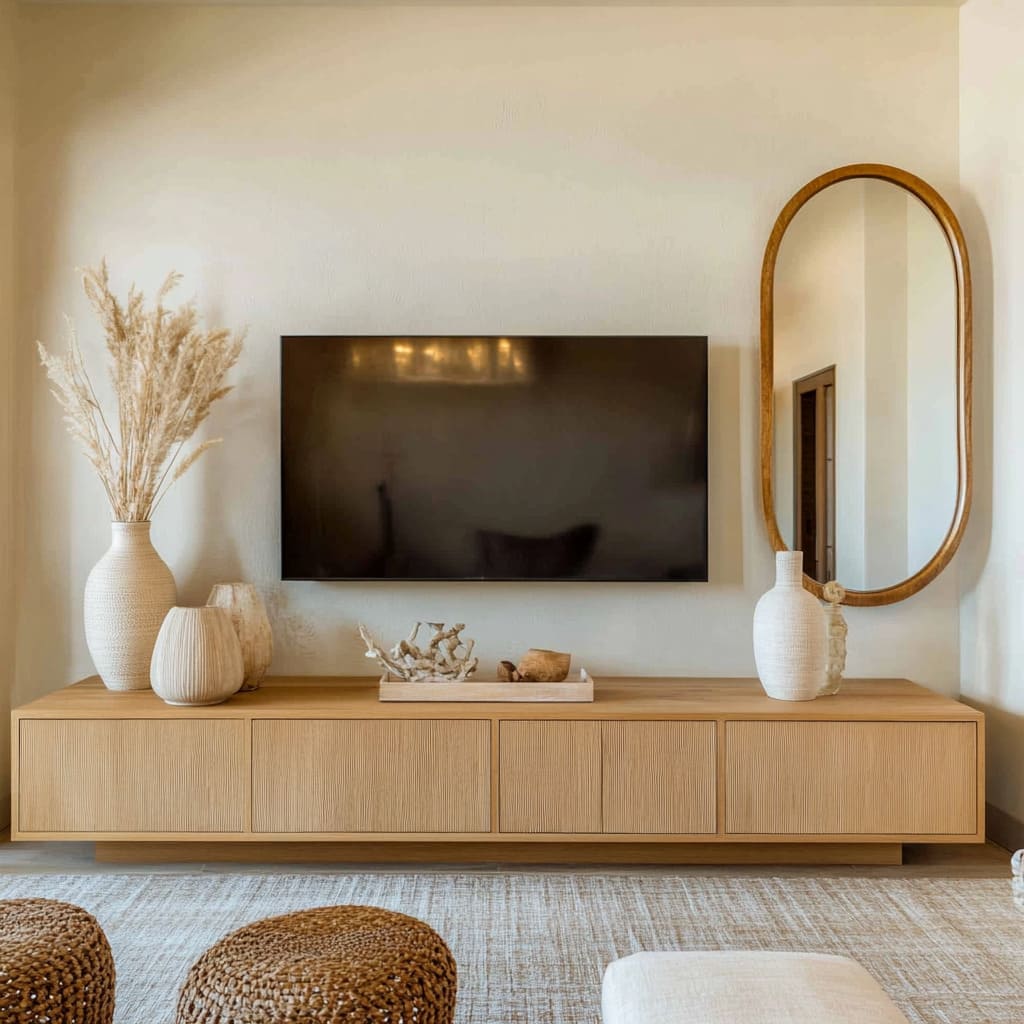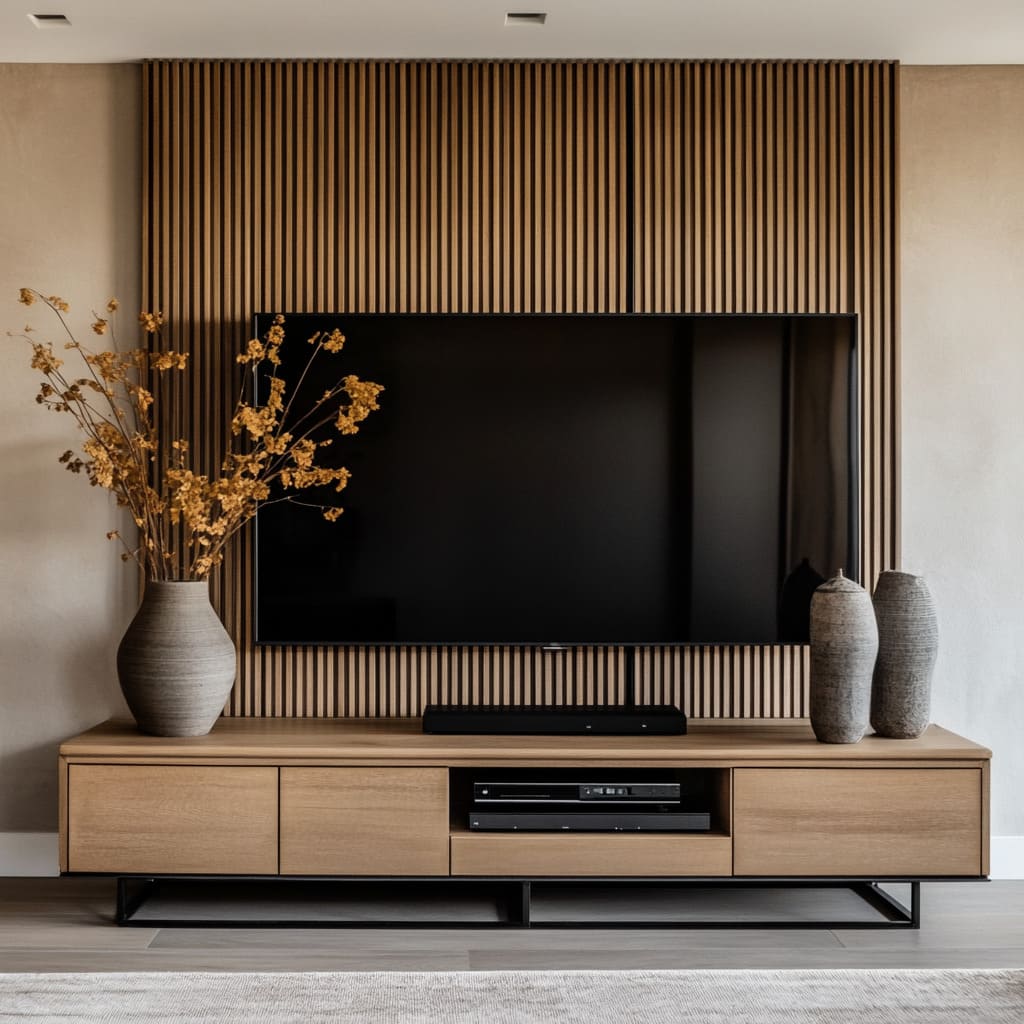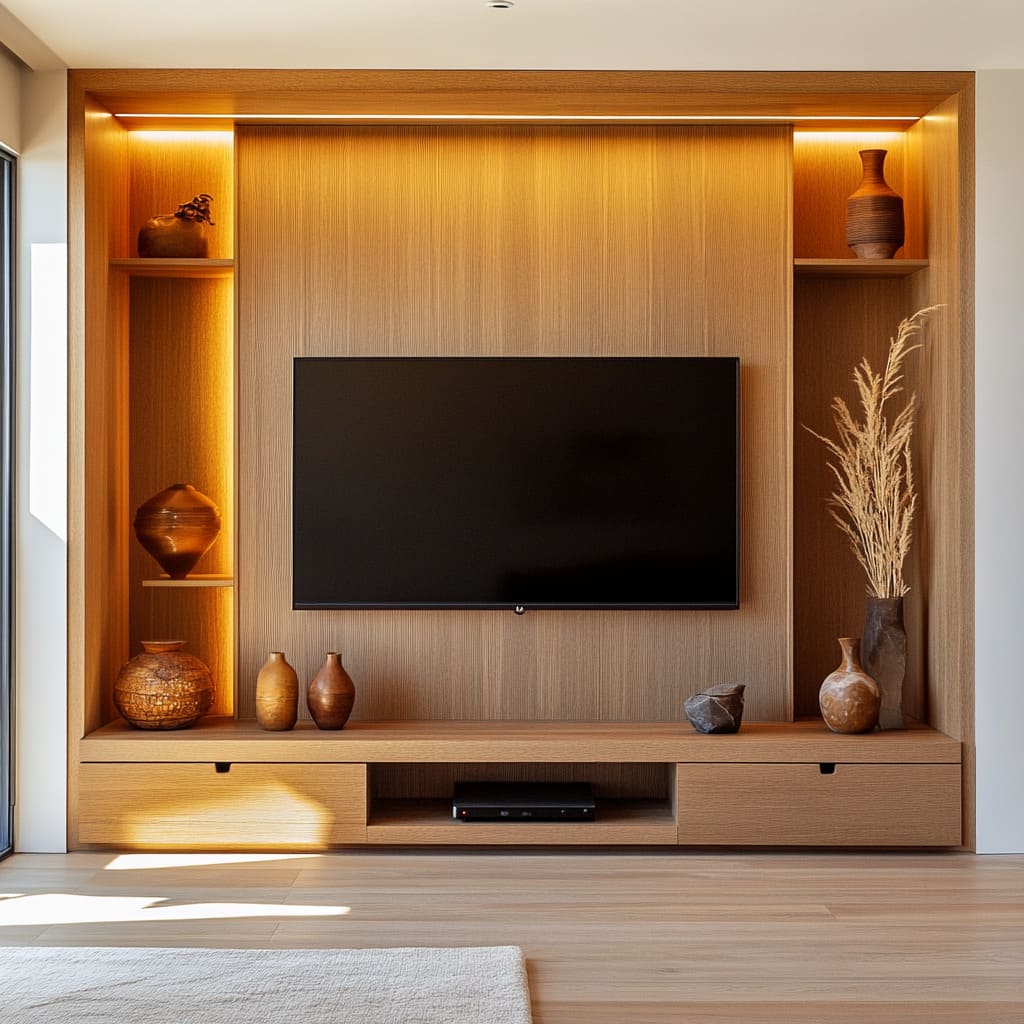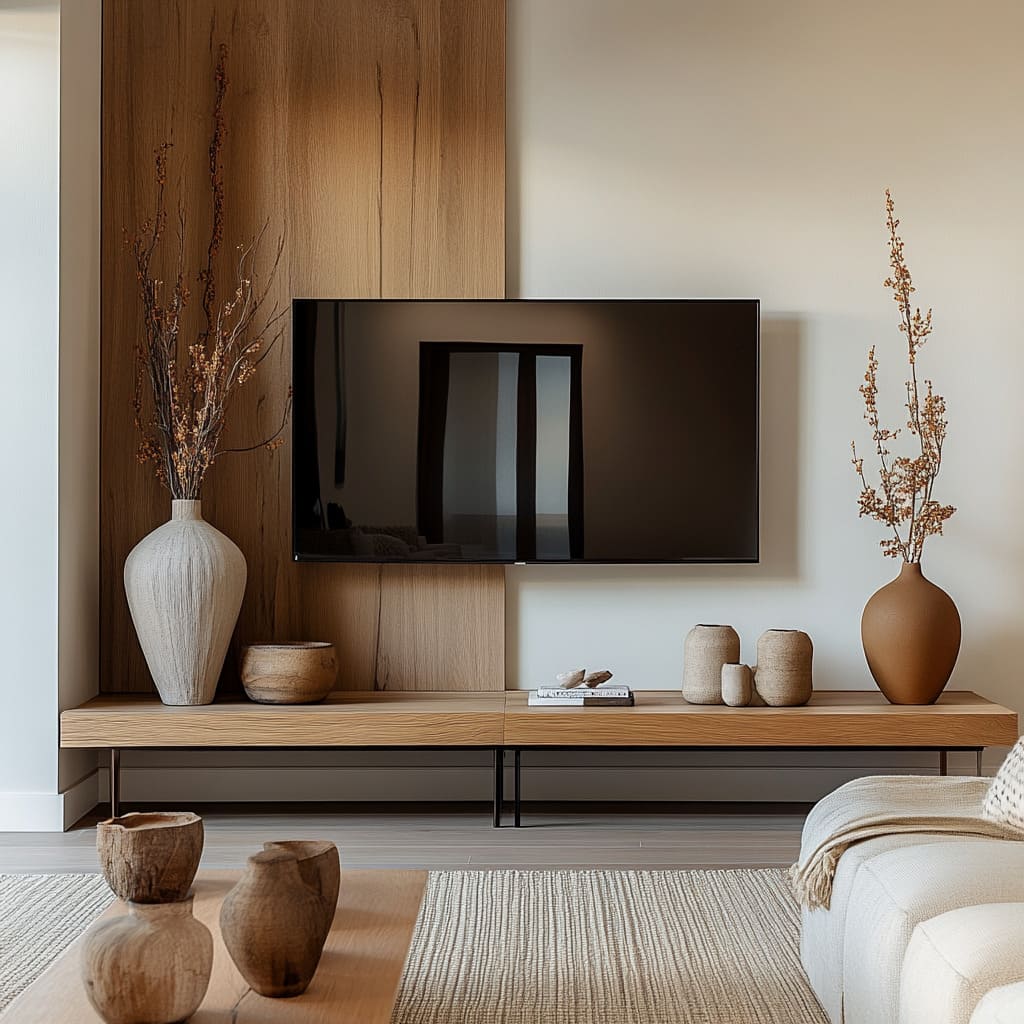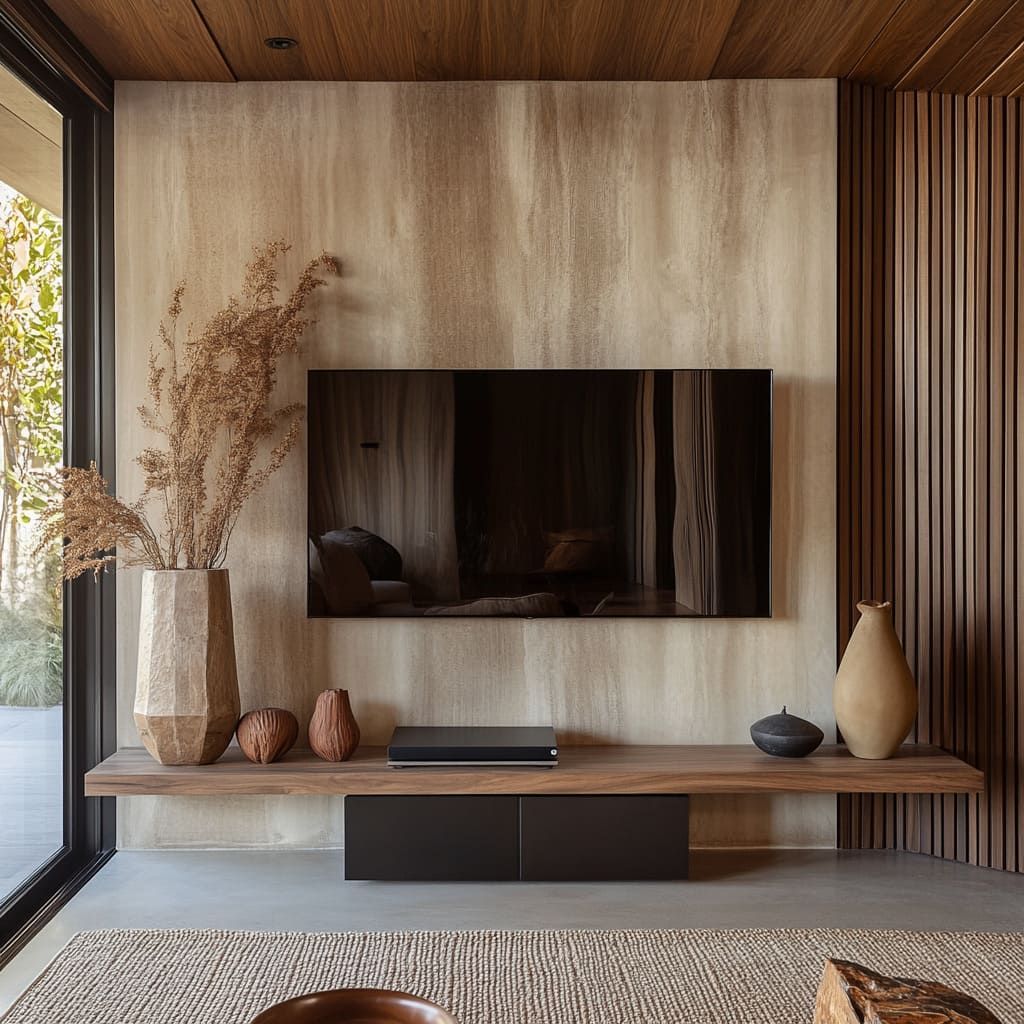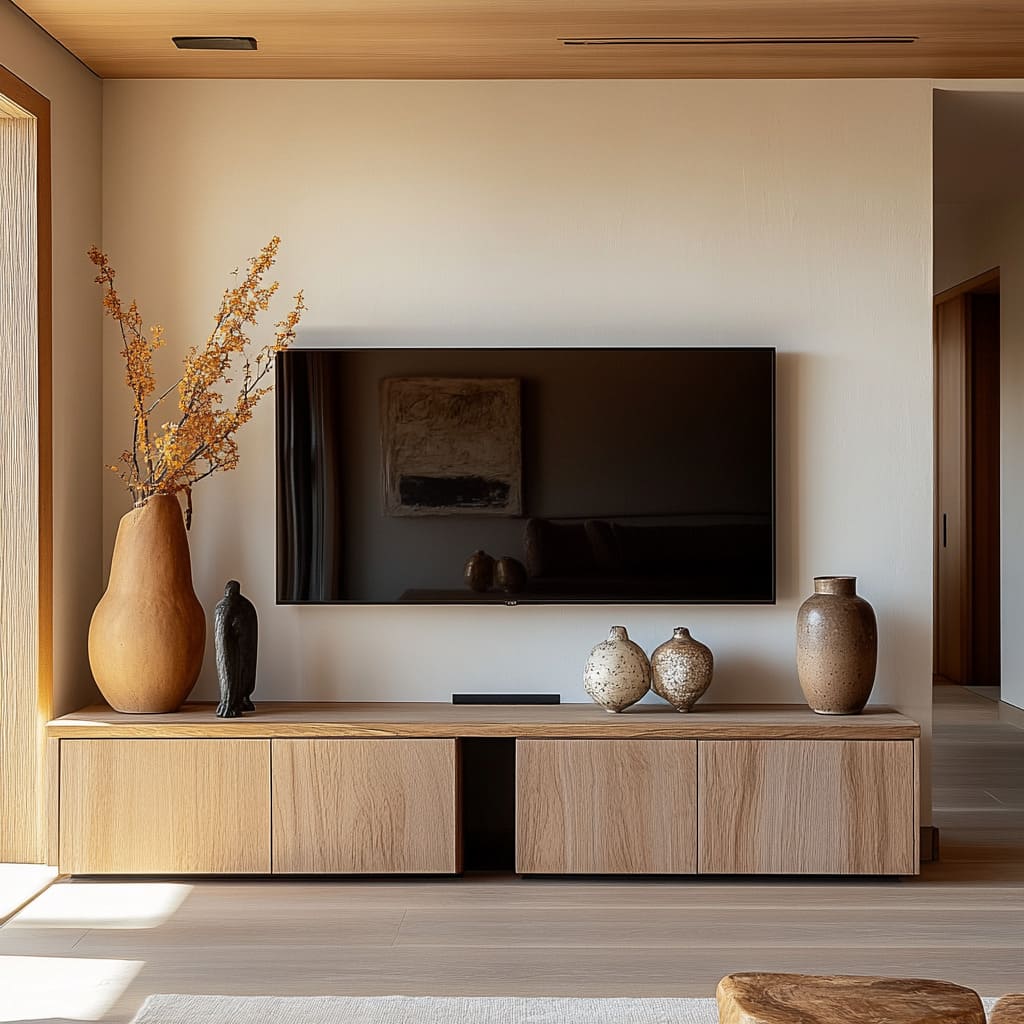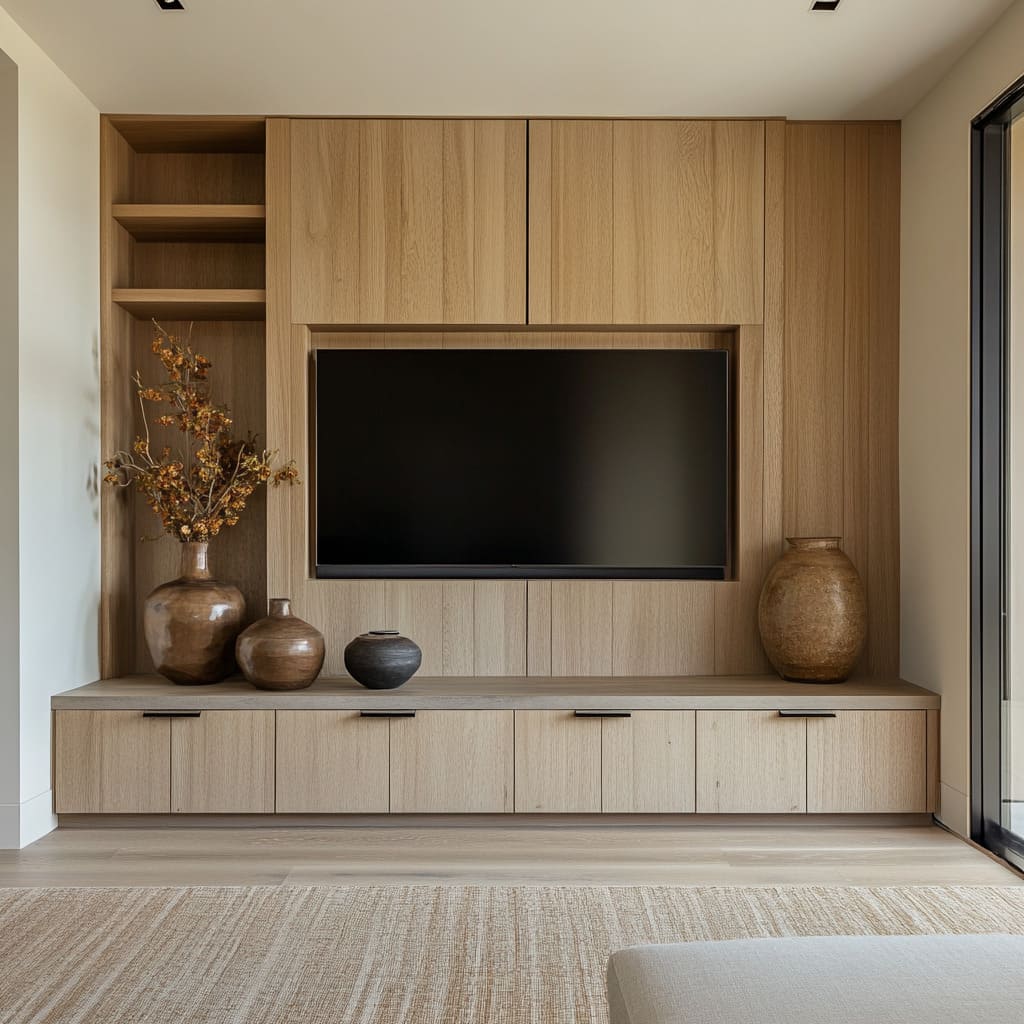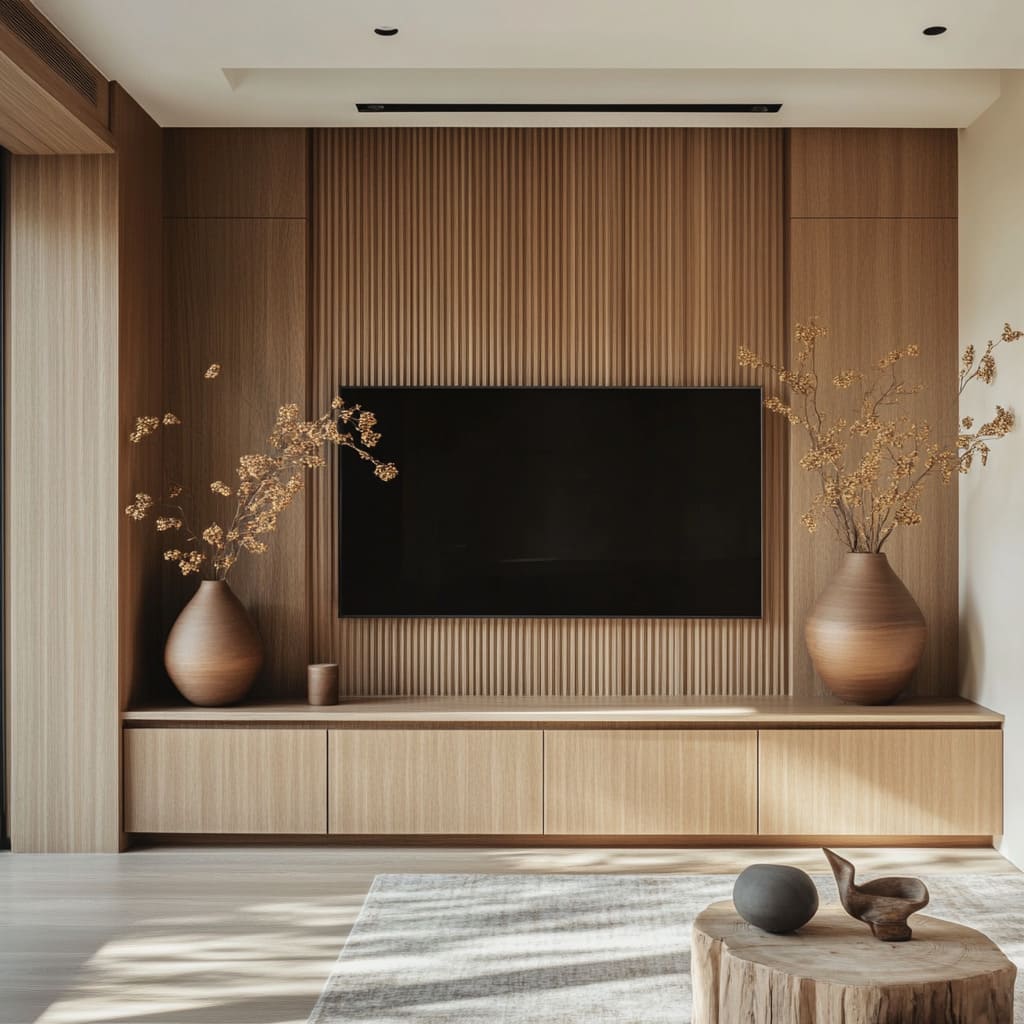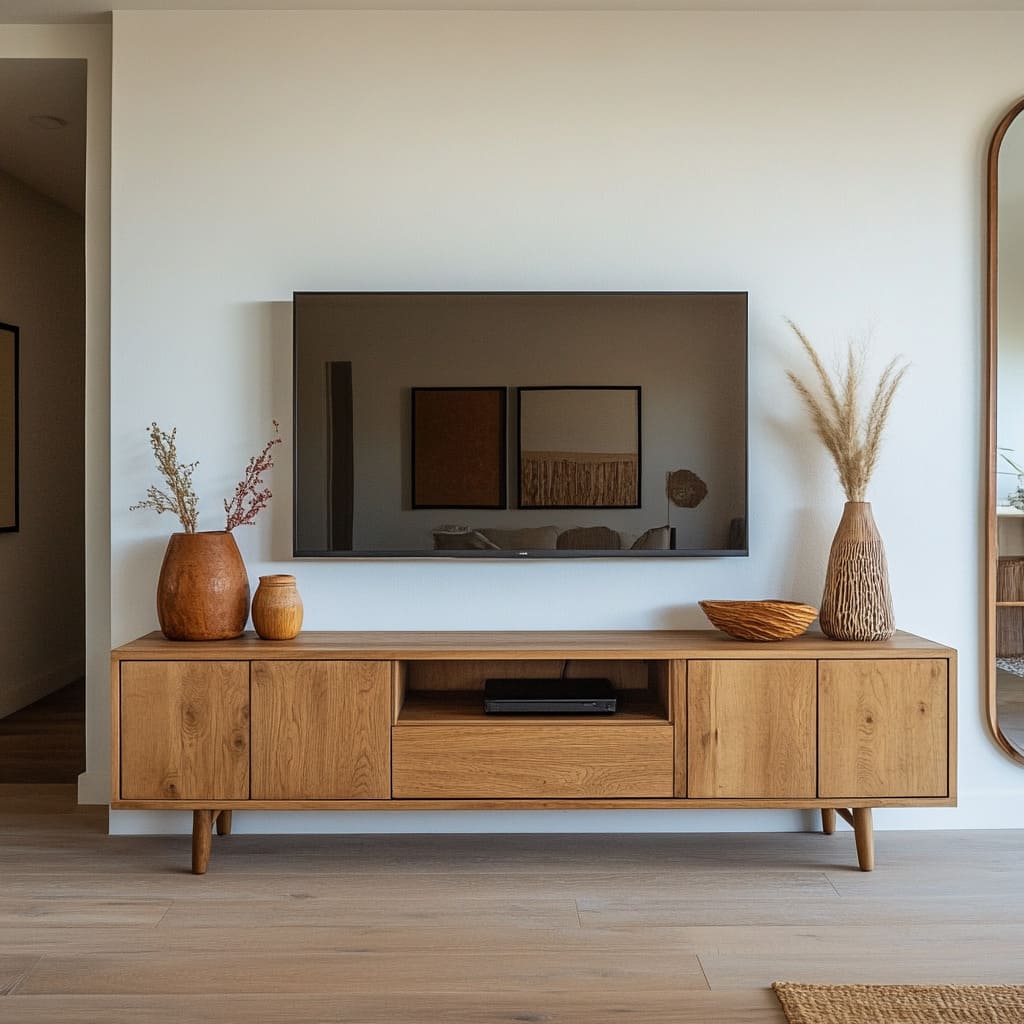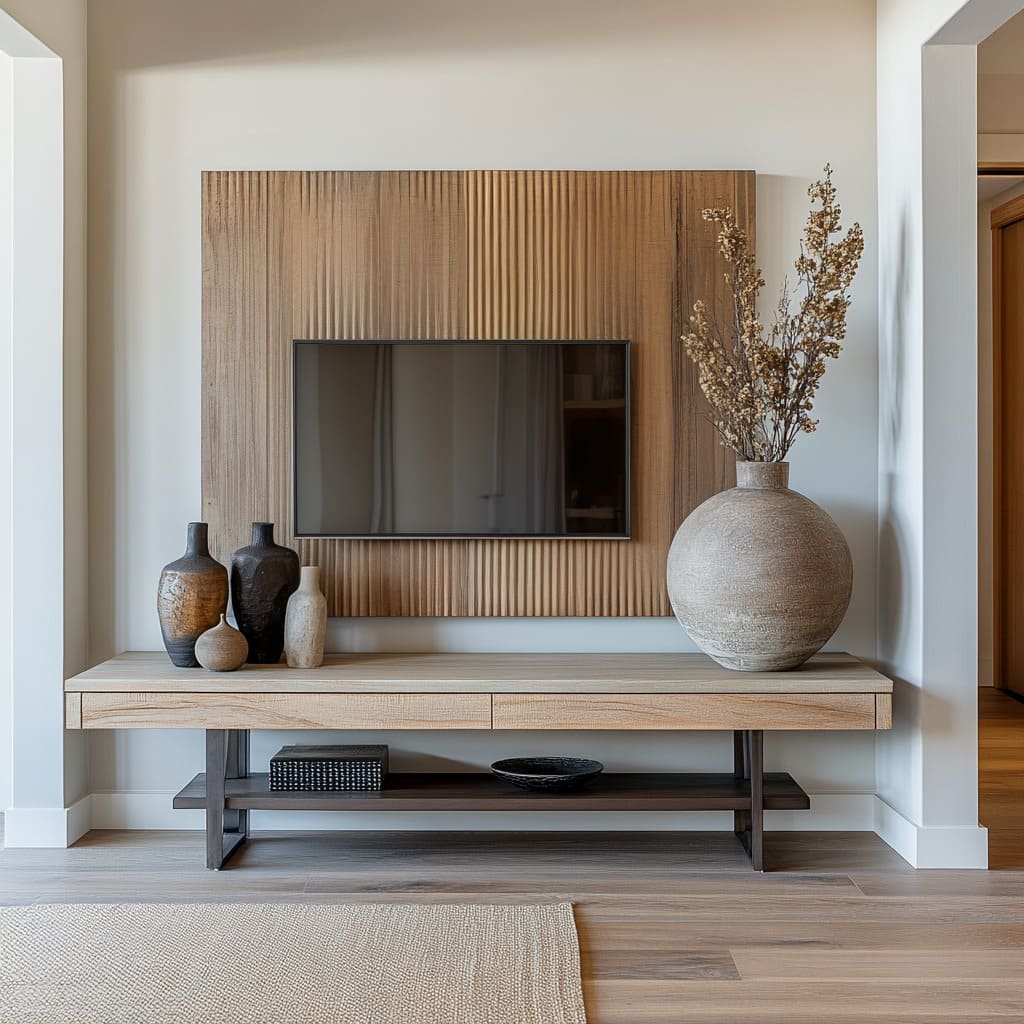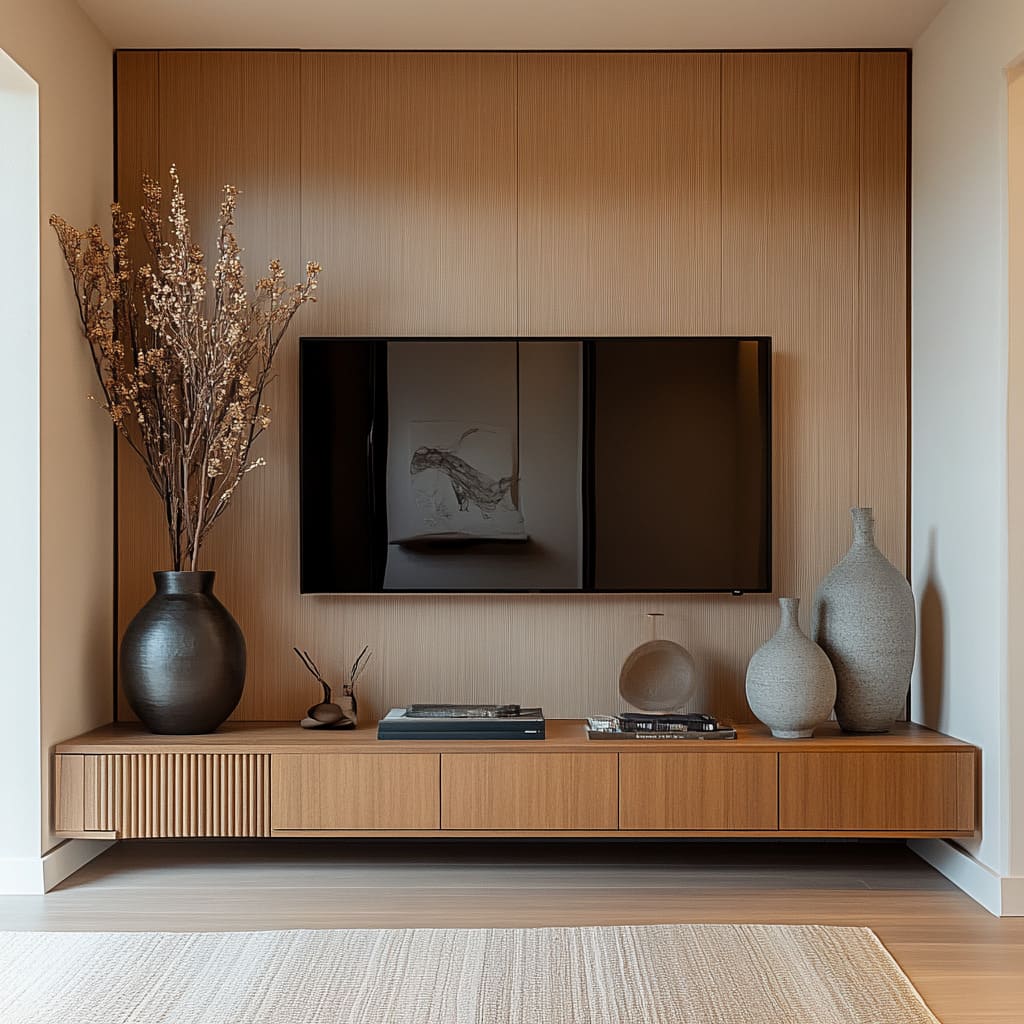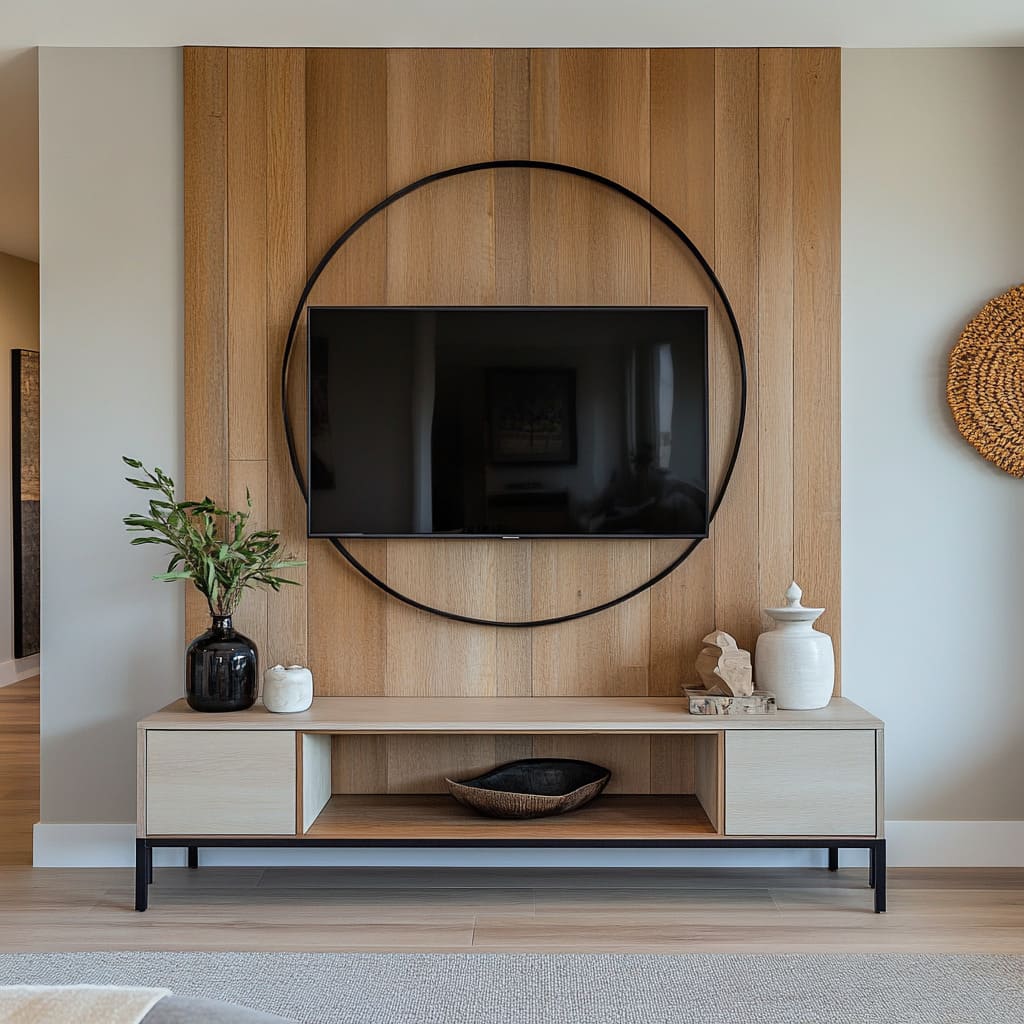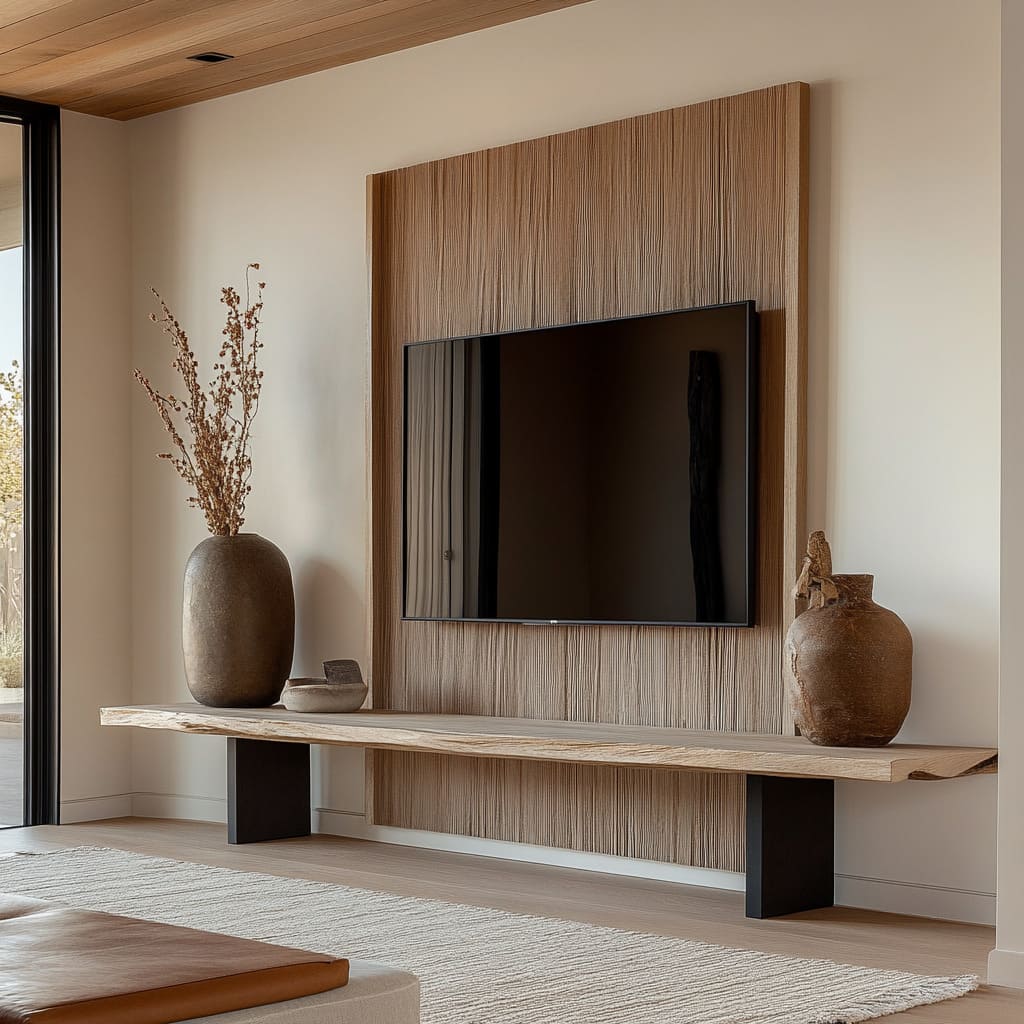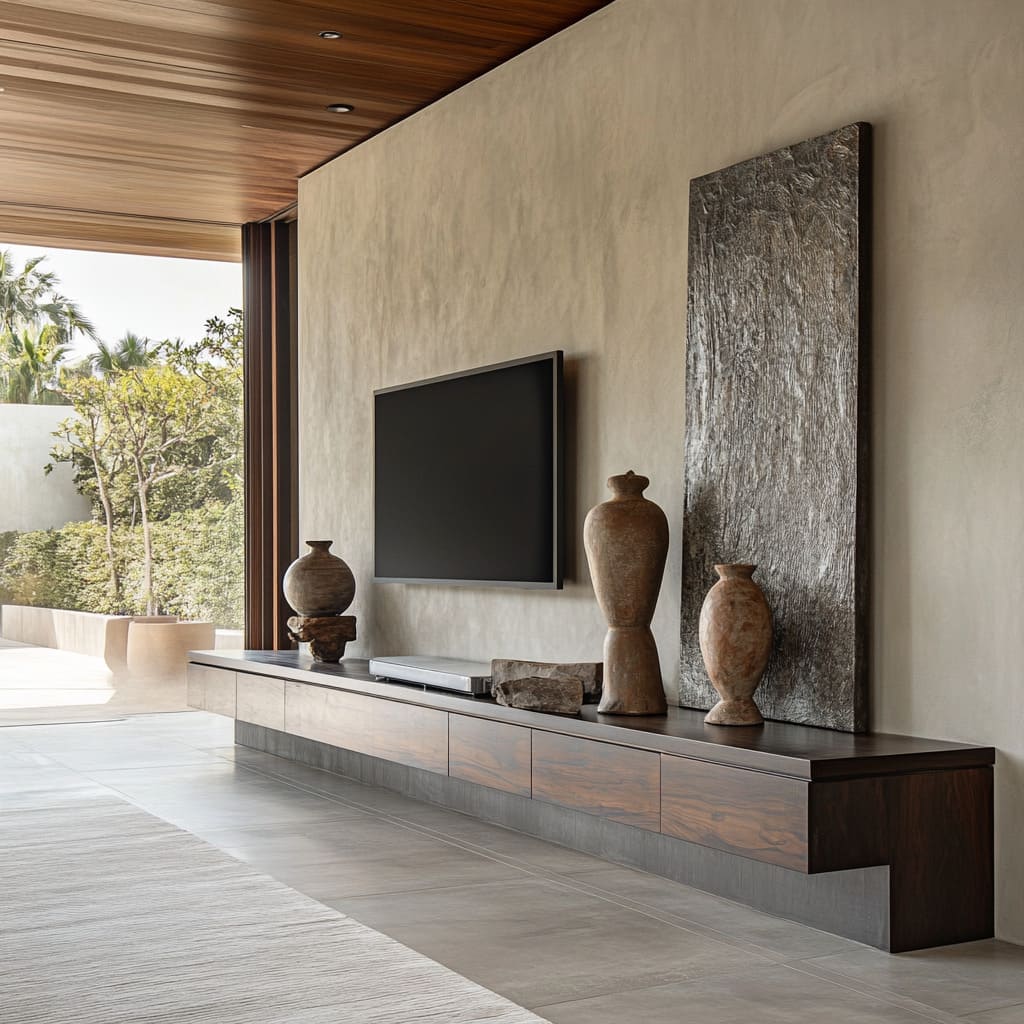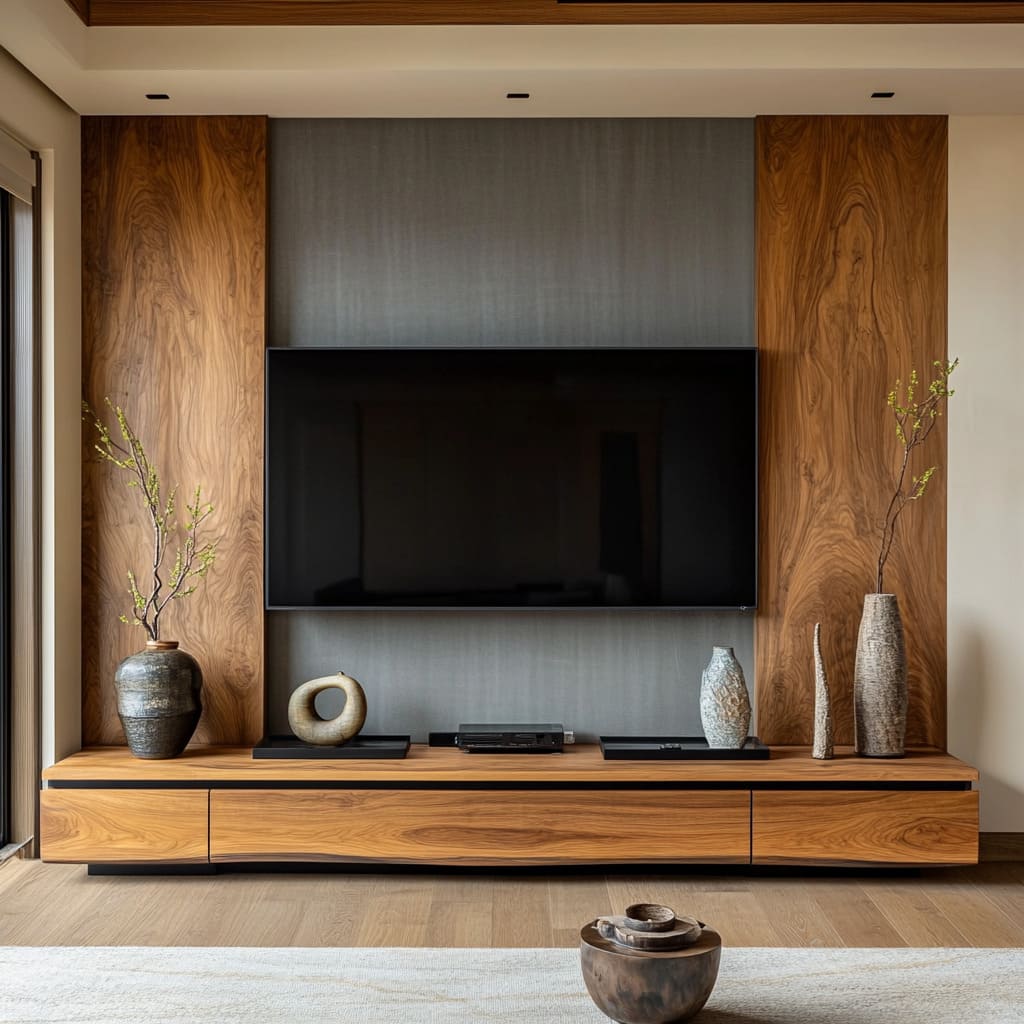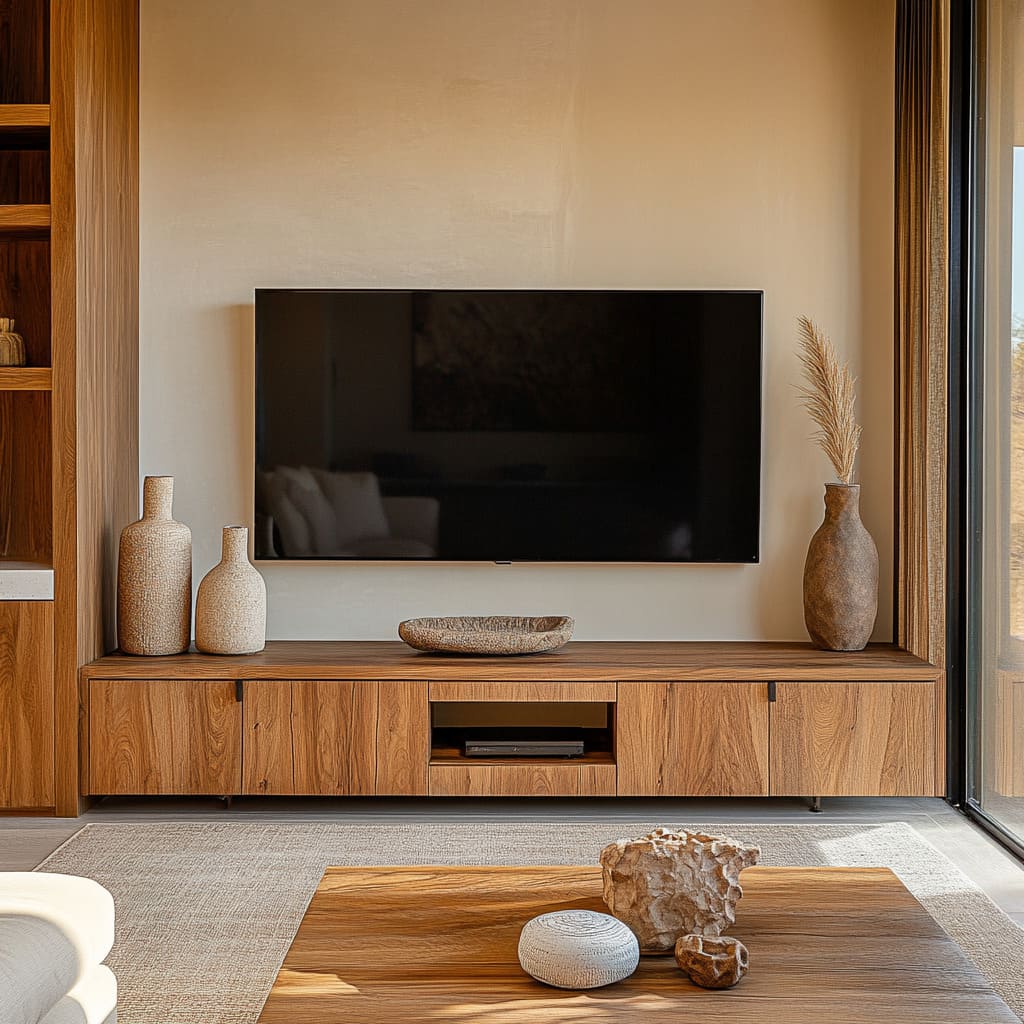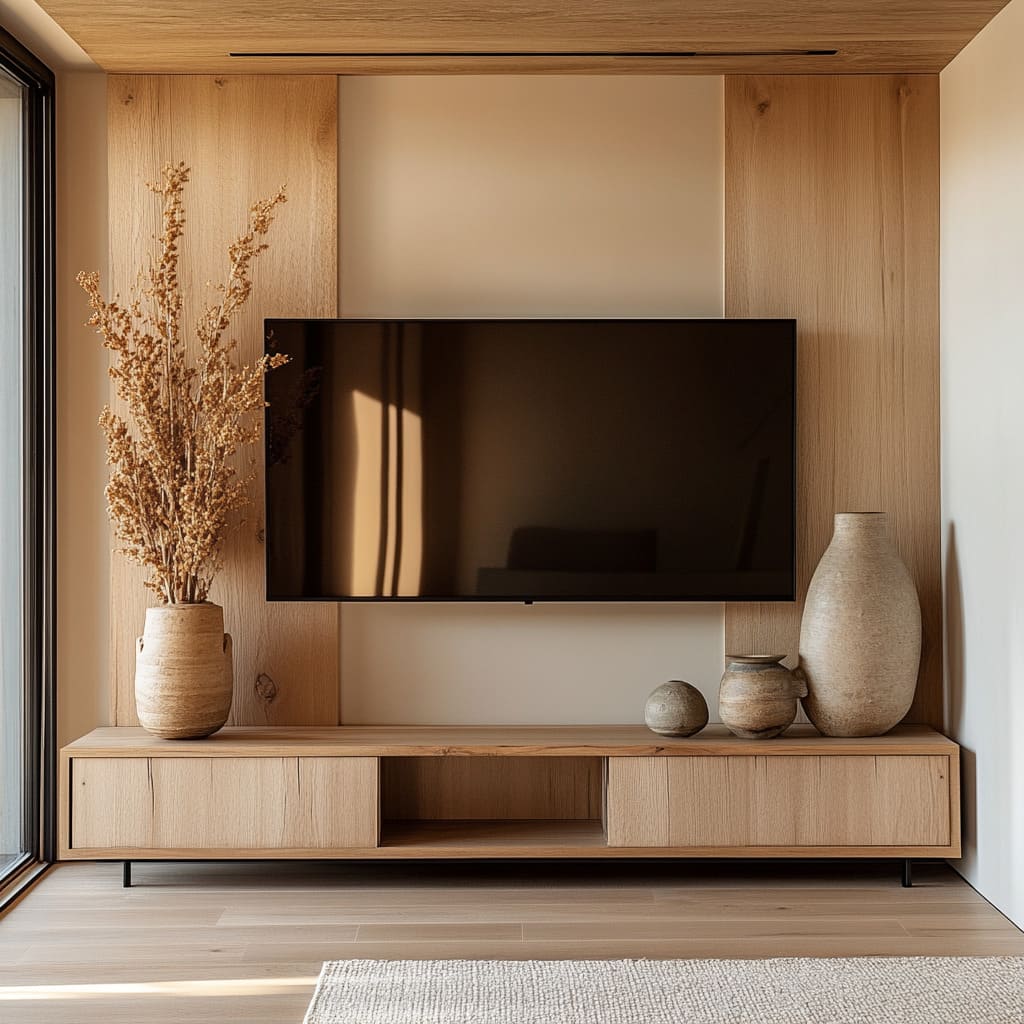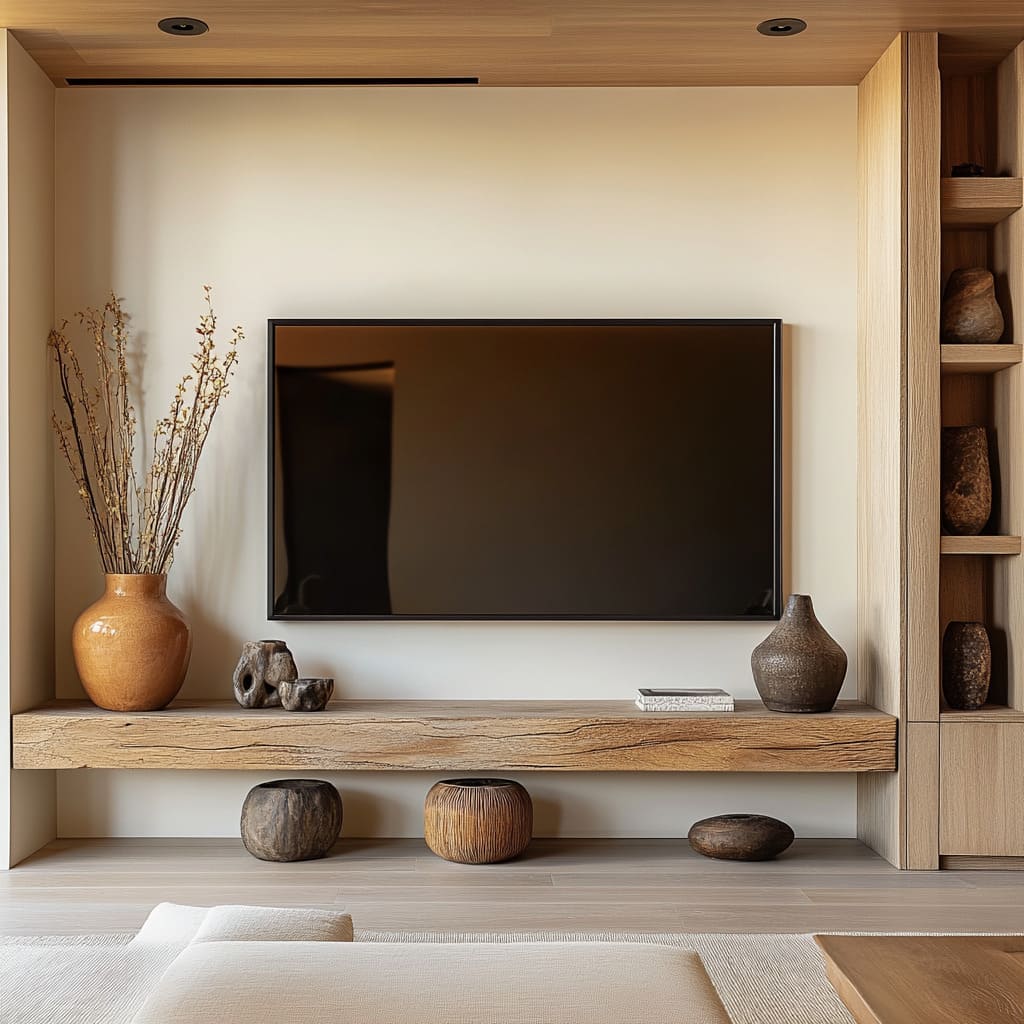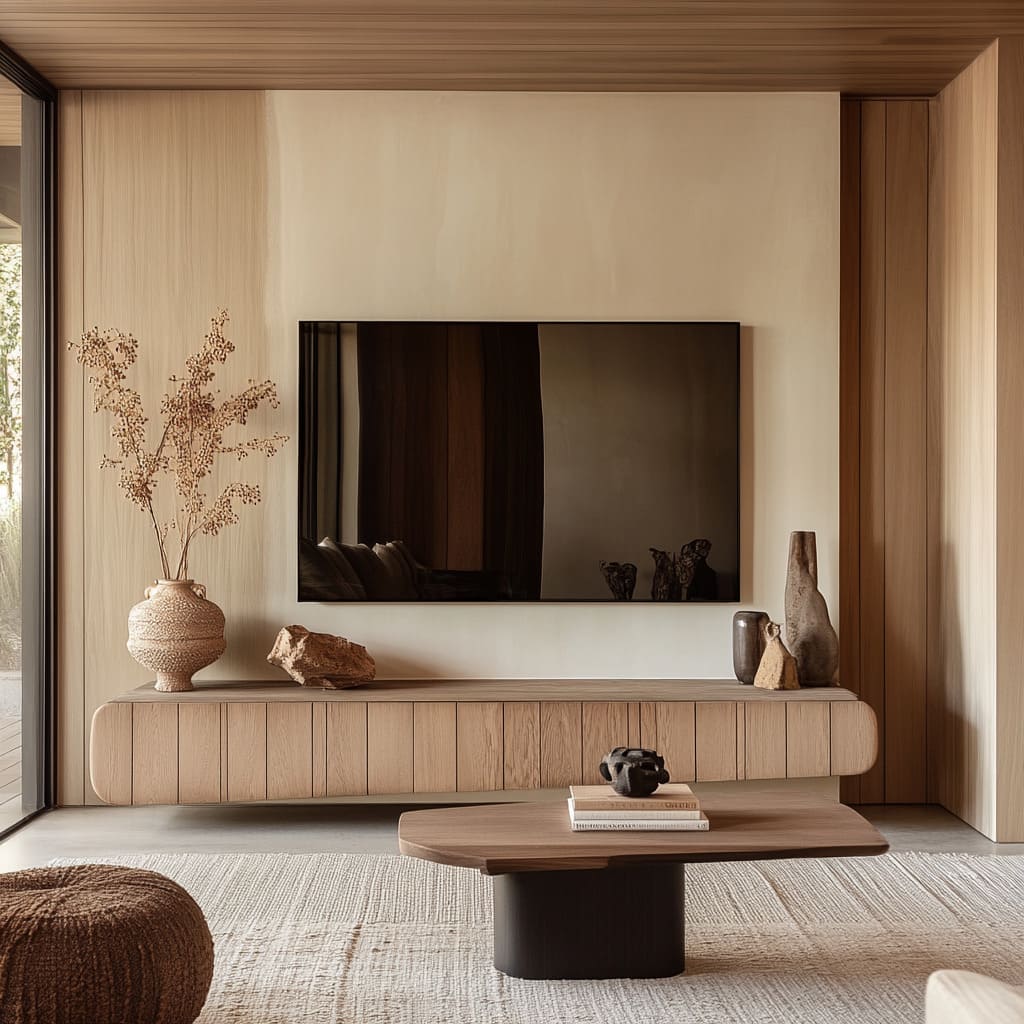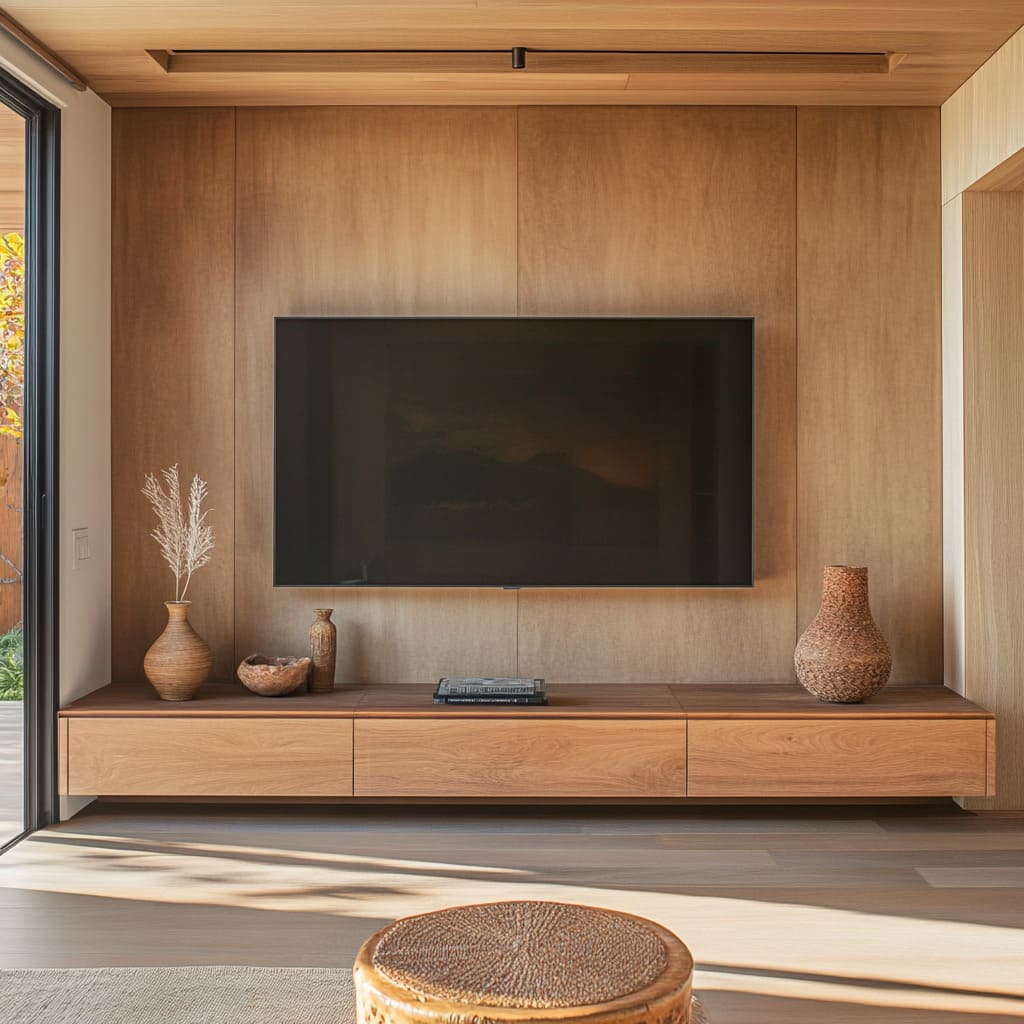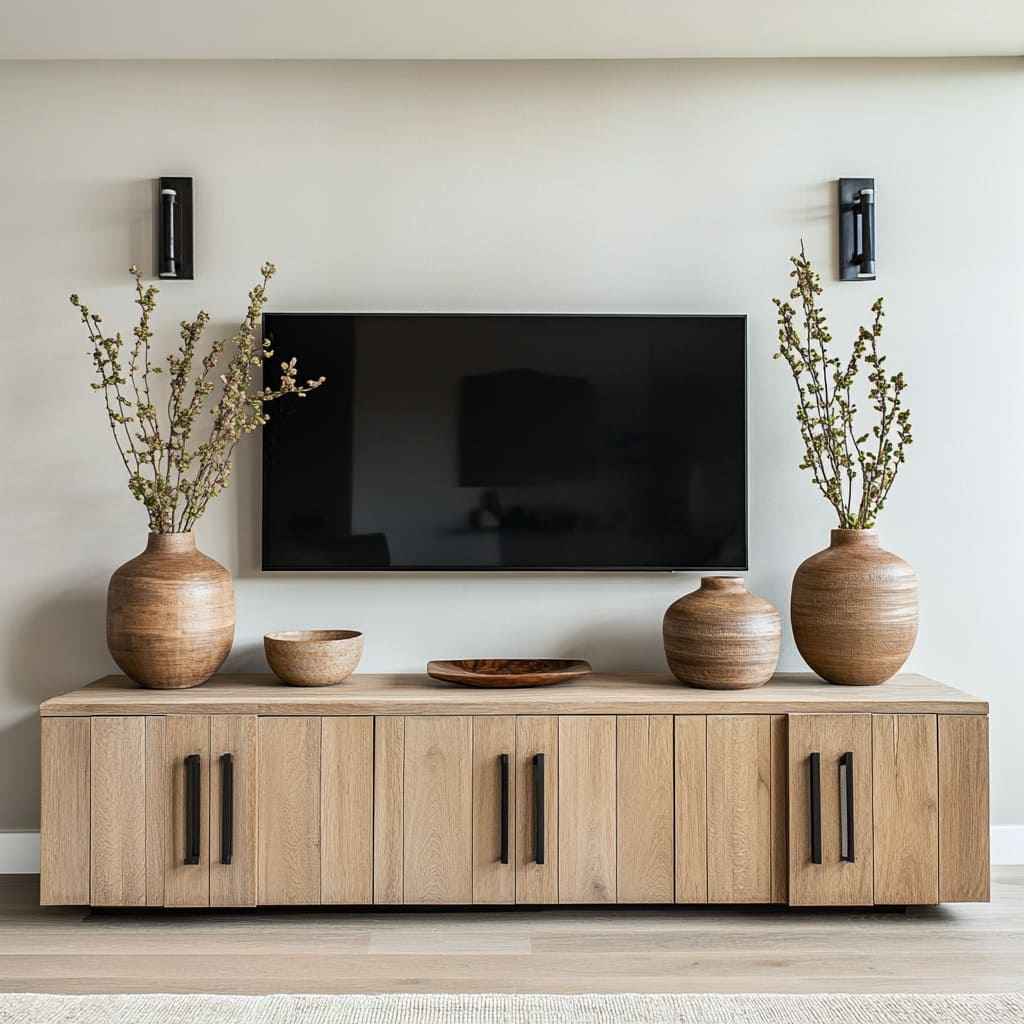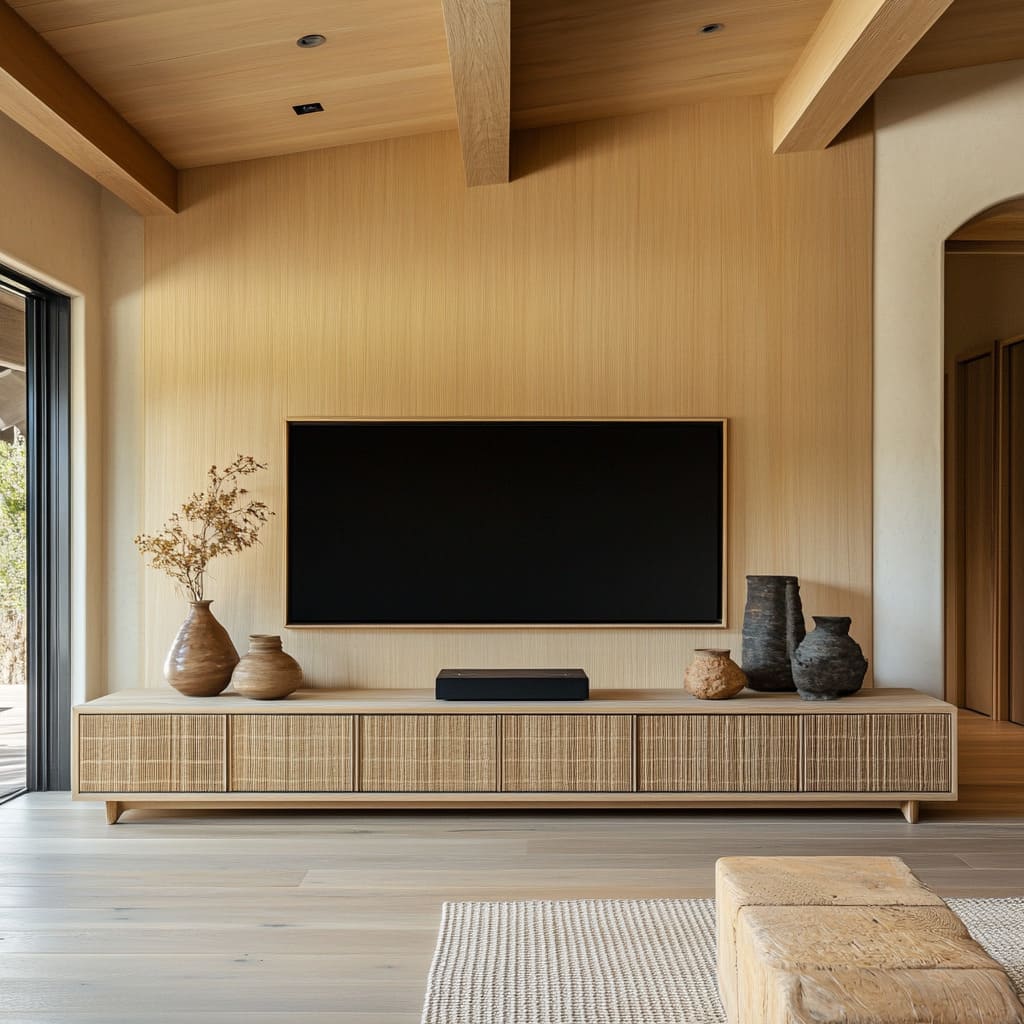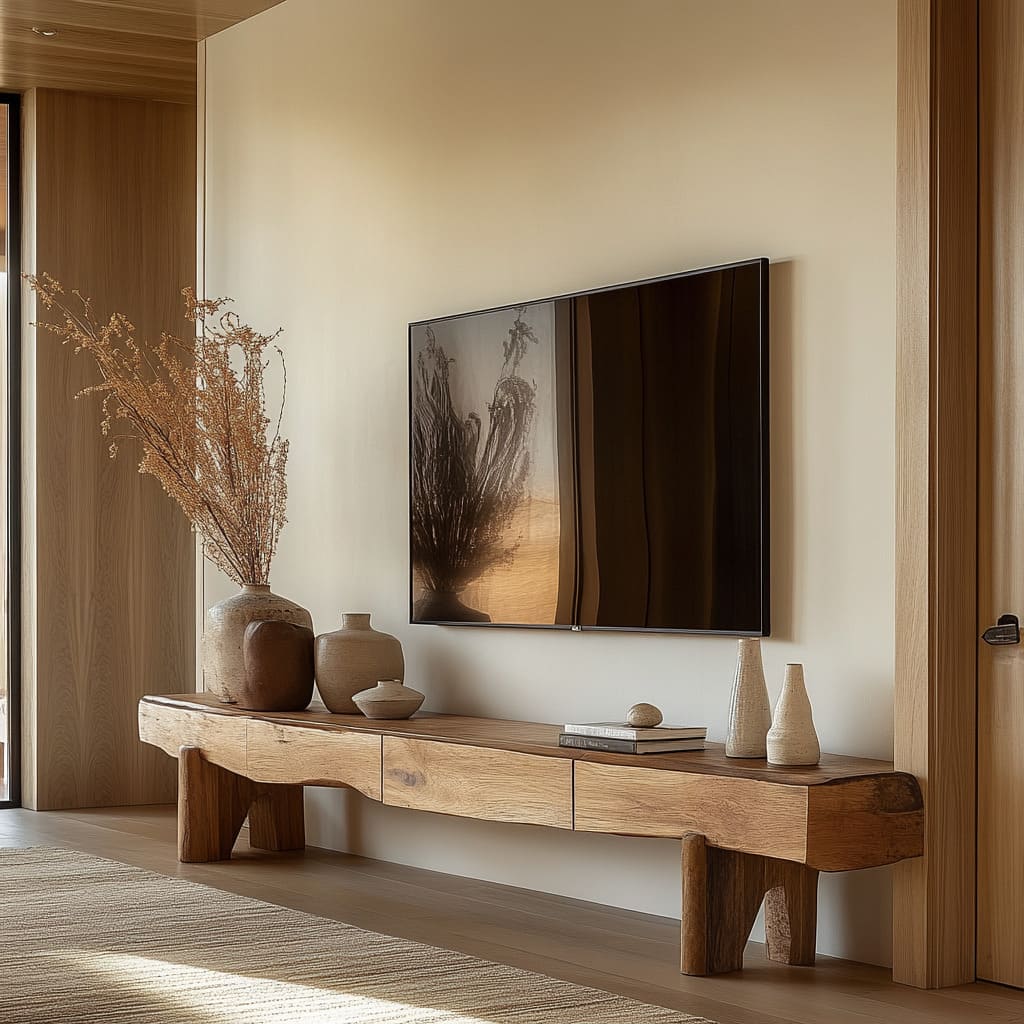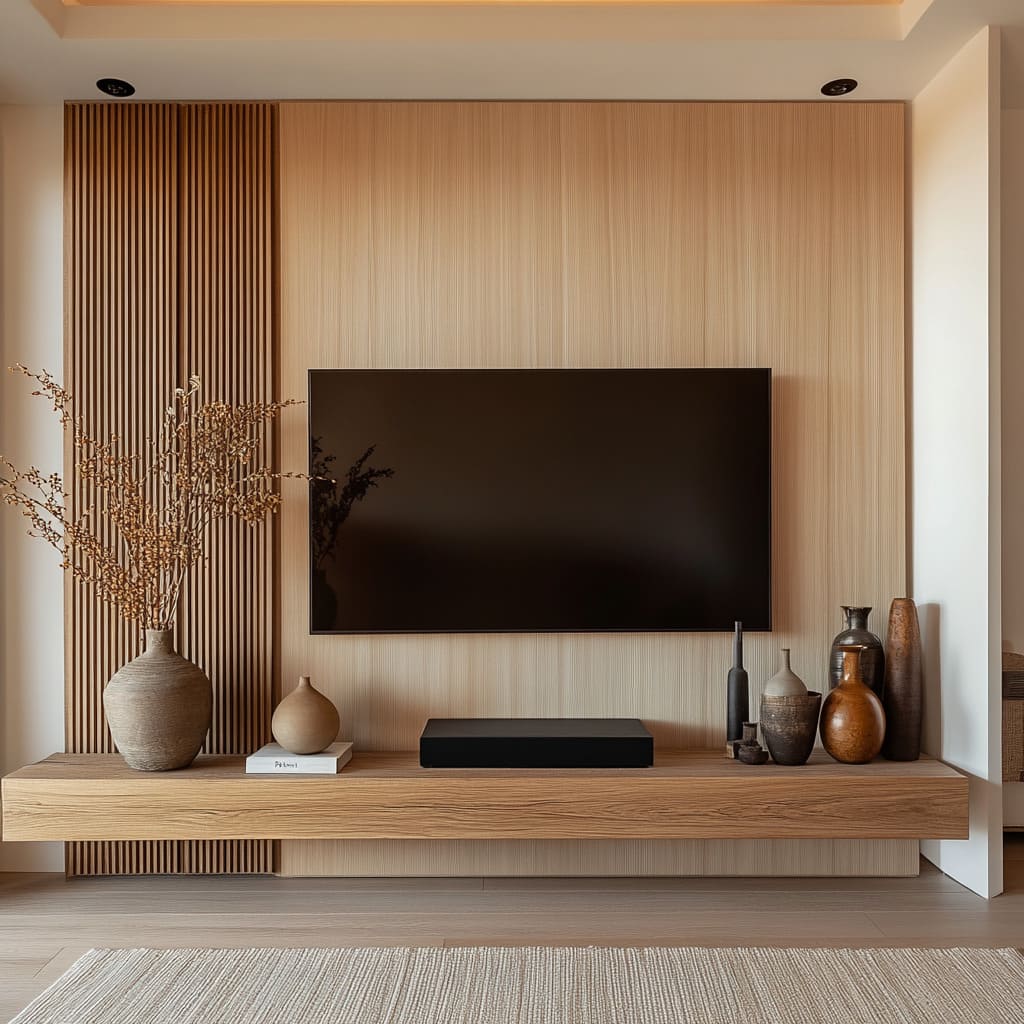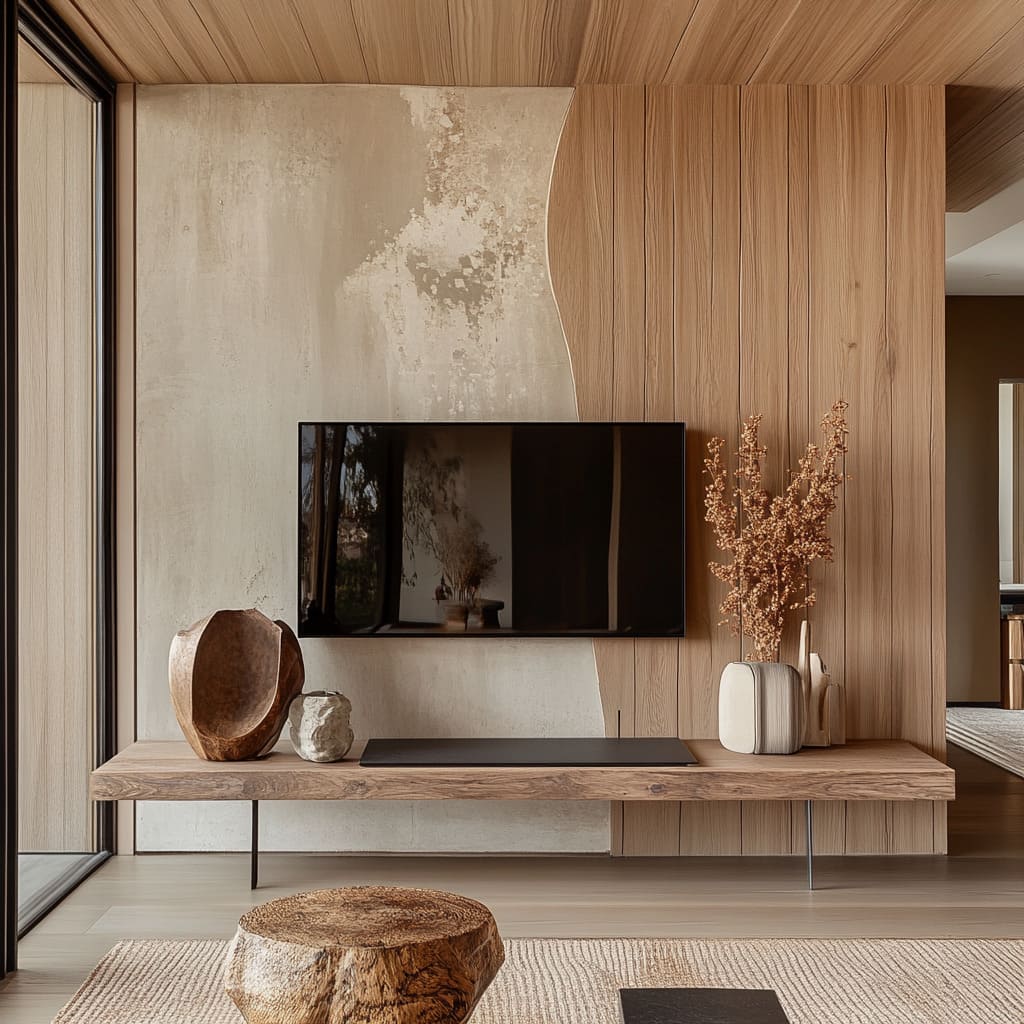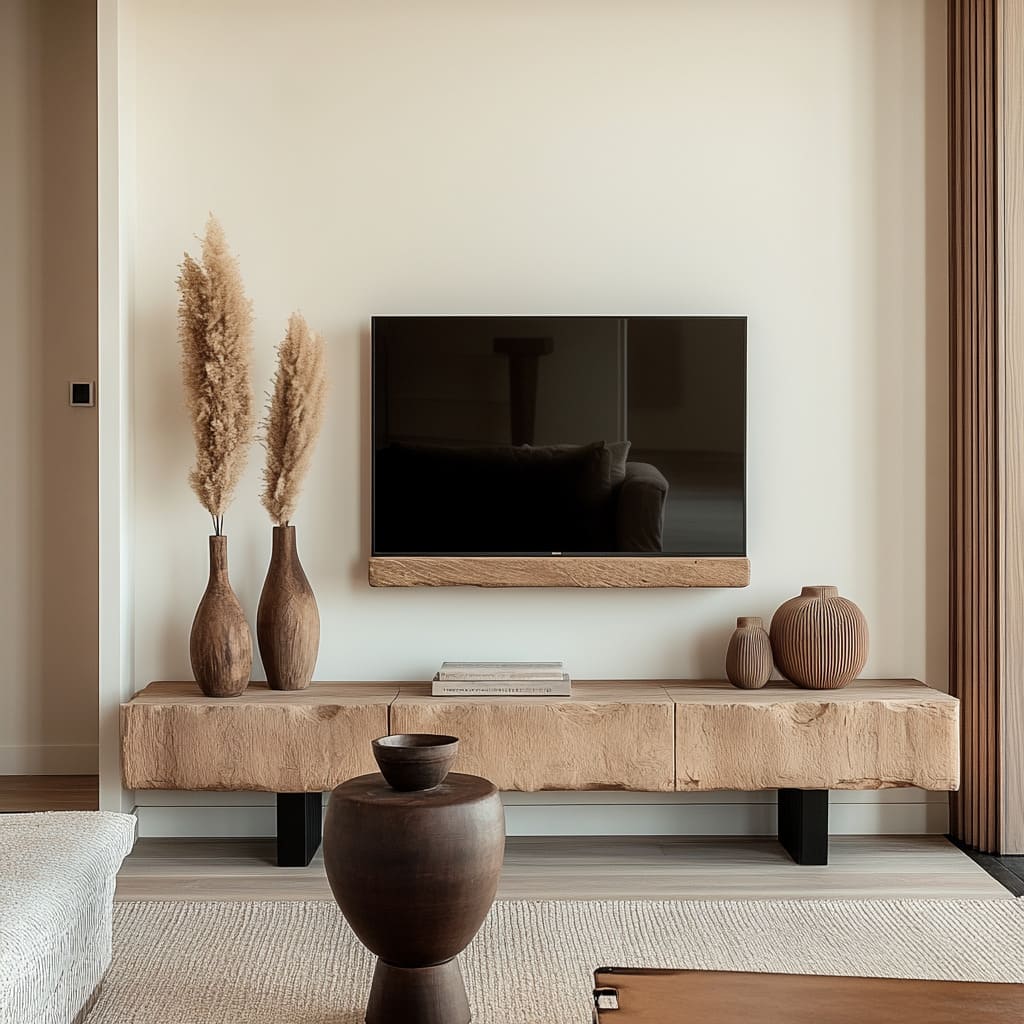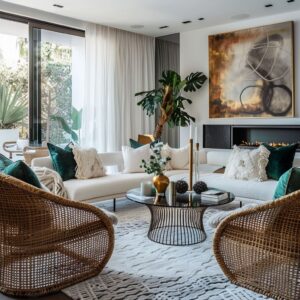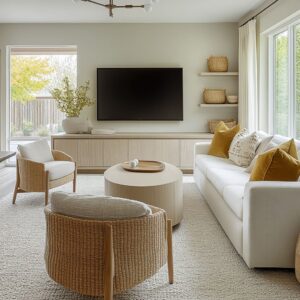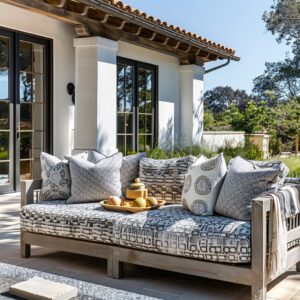In recent years, TV wall designs have become a significant focal point in modern interior design, transforming the way we think about living room spaces. The growing popularity of TV wall designs reflects a shift towards creating functional, aesthetically pleasing areas that serve multiple purposes.
No longer just a place to mount a television, the TV wall has evolved into a statement feature that adds depth and character to a room, often blending storage, display, and decor into a single cohesive unit. This evolution is driven by a desire to maximize both style and function, resulting in creative solutions that cater to diverse tastes and preferences
A unique approach that has gained traction is the blending of different design styles—Minimalist, Farmhouse, and Japandi—into a single, harmonious TV wall design. This fusion creates a space that balances simplicity, warmth, and natural beauty, appealing to those who appreciate both modern and traditional aesthetics.
By merging these distinct styles, homeowners can achieve a look that is clean and uncluttered yet cozy and inviting. This combination allows for a versatile design that can adapt to various home environments, from urban apartments to rural retreats
This article delves into the detailed elements that define each of these styles, providing inspiration and modern media wall ideas for those looking to enhance their living space. The focus is on using natural materials, simple forms, and functional layouts to create a TV wall that is both practical and visually appealing.
Whether you are interested in a minimalist tv wall design, a rustic farmhouse look, or the balanced elegance of Japandi, this guide will help you understand how to incorporate these elements into your own home
Understanding the Key Design Styles
Minimalist Style
The minimalist style is defined by its core principles of simplicity, clean lines, and uncluttered spaces. Rooted in the philosophy of less is more, this style emphasizes the importance of functionality and efficiency.
In the context of TV wall design, minimalism focuses on reducing visual noise to highlight the television as the central feature. A minimalist tv wall design often features a sleek, flat-panel TV mounted on a smooth, neutral backdrop, such as a white or light gray wall.
The surrounding elements are kept to a minimum, with a preference for concealed storage solutions that keep the area tidy and organized
Neutral color palettes are a hallmark of minimalist design, with shades like white, gray, beige, and black dominating the scheme. These colors create a calm environment that allows the TV to stand out without distraction.
Functional elements, such as floating shelves or simple cabinets, are strategically placed to offer storage without cluttering the visual flow. The goal is to create a seamless integration of technology and design, where the TV wall serves both aesthetic and practical purposes
Farmhouse Style
In contrast to the minimalist approach, the farmhouse style brings a touch of rustic charm to modern interiors. This style is characterized by its use of natural materials, earthy tones, and a cozy, lived-in feel.
Modern farmhouse tv wall ideas often incorporate wood textures, such as reclaimed barn wood or shiplap, to add warmth and character to the space. These wood elements can be used as paneling behind the TV or as part of a built-in unit that combines open shelving with closed cabinets
Handcrafted elements play a significant role in farmhouse design, adding authenticity and a sense of history. Decorative objects, such as ceramic vases, woven baskets, and vintage accessories, are commonly used to enhance the cozy ambiance.
These items not only serve as visual accents but also add texture and depth to the design. A farmhouse-style TV wall might feature a mix of open and closed storage, allowing for the display of treasured items while keeping the area functional and organized.
The combination of rustic materials and thoughtful decor creates a welcoming space that feels both timeless and contemporary
Japandi Style
Japandi is a hybrid style that combines the elegance of Japanese minimalism with the warmth of Scandinavian design. A japandi tv wall embodies the principles of both cultures, focusing on simplicity, functionality, and a connection to nature.
This style is marked by clean lines, natural materials, and a neutral color palette, with an emphasis on creating a balanced and harmonious environment. In a Japandi-inspired TV wall design, you might find a blend of light woods, such as oak or ash, combined with textured wall finishes like plaster or muted paint colors
The importance of balance and harmony is central to Japandi design. Elements are carefully chosen to complement each other, creating a sense of calm and order.
The use of functional minimalism ensures that every item has a purpose, whether it’s a piece of furniture or a decorative accessory. A simple tv unit design is typical in Japandi interiors, often featuring low-profile cabinets with clean lines and minimal hardware.
These units provide ample storage while maintaining a sleek, understated appearance. The overall effect is one of tranquility and simplicity, where each element contributes to a cohesive whole
By understanding these key design styles, homeowners can explore modern tv wall design ideas that reflect their personal tastes and complement their living spaces. Whether you lean towards the clean lines of minimalism, the rustic appeal of farmhouse decor, or the balanced approach of Japandi, blending these styles can create a unique and inviting TV wall that enhances both form and function
Estimate the Cost of Transforming Your Living Room with a TV Wall
Curious about how much it would cost to upgrade your living room with a stylish TV wall? Whether you’re thinking of installing a custom media unit or integrating modern decor elements, our calculator gives you a clear picture of your potential expenses.
[living_room_tv_wall_calculator]
Key Elements of a Unique Media TV Wall Design
Creating a standout TV wall involves thoughtful consideration of various elements that contribute to both aesthetics and functionality. By blending materials, finishes, and design styles, you can craft a unique feature that serves as the focal point of the living space.
This section explores the essential components that make up a unique media TV wall design, drawing from minimalist, farmhouse, and Japandi influences
Wall Finishes and Textures
The choice of wall materials plays a crucial role in setting the tone for any TV wall design. Different textures and finishes can transform a plain wall into a dynamic backdrop for a television.
For a contemporary tv wall design, wood paneling is a popular choice, offering warmth and natural beauty. Vertical grooves in the paneling add a subtle pattern, creating visual interest without overpowering the space.
These grooves can be thin and closely spaced for a refined look or wider apart for a more relaxed feel, depending on the overall style desired
Textured plaster finishes are another option, providing a softer, more organic look. They can mimic the appearance of natural stone or raw concrete, adding depth and character to the wall.
Wavy textures, in particular, introduce a sense of movement and flow, enhancing the wall’s visual appeal. Smooth finishes, such as matte or glossy paint, can be used to contrast with textured elements, creating a dynamic composition that draws the eye toward the TV
Combining different textures—smooth, rough, matte, and glossy—adds a layer of complexity to the design. A rough, matte wood panel paired with a glossy plaster section can create a striking contrast, making the TV wall a central feature.
This approach not only adds depth to the space but also highlights the television as a focal point, fitting perfectly within modern tv wall design concepts
Floating Shelves and Consoles
Floating shelves and consoles are key features in many modern media wall designs, offering both functional benefits and aesthetic appeal. A floating wooden console, especially one with a live-edge design, adds a touch of rustic charm to the setup.
The natural, uneven edge of the wood brings in an organic feel, which is a nod to farmhouse tv wall ideas, blending rustic elements with a more refined modern style
Sleek, handle-less cabinets and shelves are essential for maintaining a minimalist aesthetic. These storage solutions keep the space looking clean and uncluttered while providing ample room for storing media equipment and accessories.
The absence of visible hardware enhances the minimalist look, making the design appear seamless and streamlined
The floating design of these elements creates a sense of lightness and openness, making the room feel larger and more spacious. It also provides flexibility in terms of layout, allowing for easy access and adjustment as needed.
This is particularly beneficial in minimal tv wall design, where the goal is to achieve a clean, unobtrusive look that complements the rest of the interior
Decorative Elements and Accessories
Decorative objects play a significant role in adding personality and character to a TV wall design. Ceramic vases, dried branches, and woven baskets are popular choices that introduce natural textures and organic forms.
These accessories not only enhance the farmhouse and Japandi styles but also add warmth and depth to the space. A well-placed ceramic vase with a rough, handmade texture can soften the look of a sleek TV wall, while dried branches in a simple vessel add a touch of nature, reinforcing a connection to the outdoors
The balance between decorative and functional elements is key to maintaining a cohesive look. Too many decorative items can overwhelm the space, while too few can make it feel sparse and unfinished.
The goal is to find a middle ground where each piece complements the others, creating a unified and harmonious design. For example, a simple arrangement of ceramic vases and a woven basket can add just enough texture and interest to enhance the wall without detracting from the TV itself
Color Palette and Material Combinations
Color and material choices are fundamental to the success of any TV wall design. Neutral and earthy color palettes are common in Minimalist, Farmhouse, and Japandi styles, providing a calm and soothing backdrop that allows the TV to take center stage.
Natural wood tones, such as oak, walnut, or ash, are often used to introduce warmth and texture, while shades of beige, gray, and muted colors help to create a balanced and harmonious space
The combination of different materials—wood, metal, ceramics—adds depth and interest to the design. Wood is a versatile material that can be used for paneling, shelving, or cabinetry, while metal accents, such as brackets or hardware, add a modern touch.
Ceramic accessories, with their varied textures and finishes, offer a contrast to the smoother surfaces of wood and metal, contributing to a rich and layered look
Incorporating a mix of materials and colors allows for greater creativity and flexibility in design, enabling homeowners to customize their TV wall to suit their style preferences and functional needs. Whether you prefer the sleek, understated look of a minimalist design, the cozy charm of farmhouse decor, or the clean lines and natural elements of Japandi, these material combinations provide endless possibilities for creating a unique and personalized space
Practical Considerations for TV Wall Design
When designing a TV wall, practical considerations are just as important as aesthetic ones. Proper planning and thoughtful design choices ensure that the TV wall is not only beautiful but also functional and efficient
Optimal TV Placement
One of the key considerations in any modern media wall design is the placement of the TV. It is essential to position the TV at an ideal viewing height, typically at eye level when seated, to ensure a comfortable viewing experience.
This avoids neck strain and makes for a more enjoyable experience when watching TV for extended periods
Hiding cables is another important aspect of a clean, uncluttered look. Cables and wires can detract from the overall design, so it’s important to incorporate solutions such as in-wall cable management systems, cable covers, or integrated cabinetry that conceals them from view.
This ensures that the TV wall remains sleek and tidy, fitting within the principles of wall mounted tv unit designs
Lighting and Ambiance
Lighting plays a crucial role in enhancing the textures and colors of a TV wall design. Natural light is always a welcome addition, as it highlights the natural beauty of wood and other materials.
However, ambient lighting is also essential, especially in the evening or in rooms with limited natural light
Recessed lighting and spotlights are effective ways to create a warm and inviting atmosphere. These lights can be strategically placed to highlight specific elements of the TV wall, such as textured panels or decorative objects.
Dimmable lights allow for greater control over the room’s ambiance, making it easy to adjust the lighting to suit different occasions and moods
Functionality and Storage Solutions
Storage is another critical aspect of TV wall design. The challenge is to incorporate storage solutions that do not compromise the minimalist aesthetic.
Concealed cabinets and drawers are excellent options for keeping media accessories, remotes, and other items out of sight, maintaining a clean and organized appearance
Open shelves can also be used to display decorative items, adding a personal touch to the space. However, it’s important to strike a balance between storage and display to avoid a cluttered look.
The latest media wall designs often feature a combination of open and closed storage, providing flexibility and functionality without sacrificing style. By considering these key elements and practical aspects, you can create a TV wall design that is both unique and functional, perfectly blending the principles of Minimalist, Farmhouse, and Japandi styles
Creating a Cohesive Look
Designing a TV wall that merges Minimalist, Farmhouse, and Japandi styles requires a careful balance of elements from each aesthetic to create a cohesive and visually appealing result. Each style brings its unique qualities to the table: the clean lines and simplicity of Minimalism, the rustic charm and warmth of Farmhouse, and the natural textures and functional elegance of Japandi.
By thoughtfully blending these elements, you can achieve a harmonious look that feels unified and well-considered
Blending Styles Seamlessly
To merge Minimalist, Farmhouse, and Japandi styles into a cohesive TV wall design, it’s essential to focus on a few key principles: balance, harmony, and intentionality in design choices. Start by selecting a neutral color palette that serves as a foundation for the different styles to coexist.
Shades of white, beige, gray, and natural wood tones are ideal, providing a calm backdrop that allows various textures and finishes to shine
When blending these styles, consider using materials that are characteristic of each aesthetic. For instance, incorporate sleek, smooth surfaces for a minimalist tv wall design while using rough-hewn wood or reclaimed barn wood to introduce a farmhouse element.
Japandi influences can be added through simple, functional pieces and natural fibers. A contemporary tv wall design might use a combination of matte finishes and organic textures to balance modern and rustic elements
Another tip for achieving a cohesive look is to mix rustic elements with sleek, modern finishes. For example, pairing a rough wooden shelf with a smooth, glossy plaster wall adds a touch of contrast and visual interest.
You could also combine a minimalist floating console with handcrafted accessories, like ceramic vases or woven baskets, to infuse a sense of warmth and character into the space. The key is to ensure that each element complements the others, creating a balanced composition that feels both intentional and effortless
Personalizing the Design
Personalization is key to making any TV wall design feel unique and reflective of your style. One way to personalize the design is by incorporating unique accessories and decor that reflect your tastes.
Consider using items that have personal meaning, such as travel souvenirs, vintage finds, or family heirlooms, to add a touch of individuality to the space. These elements can provide a sense of depth and storytelling, making the TV wall more than just a backdrop but a reflection of your life and experiences
Bespoke furniture pieces and custom-built elements also play a significant role in creating a one-of-a-kind design. Custom-made consoles, shelving units, or even cabinetry can be designed to fit the specific dimensions and needs of your living space, ensuring a perfect fit both functionally and aesthetically.
For example, a custom-built TV unit that combines closed storage with open display areas can serve as a central piece that ties the entire room together. By choosing custom elements, you can control every aspect of the design, from materials to finishes, to perfectly align with your vision
Conclusion
Throughout this article, we’ve explored how to create a unique media TV wall design by blending elements from Minimalist, Farmhouse, and Japandi styles. By understanding the key components of each style—such as the importance of simplicity in Minimalism, the rustic textures of Farmhouse, and the natural elegance of Japandi—you can create a cohesive and visually appealing design that enhances your living space
Blending different styles offers versatility and appeal, allowing for a design that is not only functional but also full of character and warmth. Thoughtful design choices and attention to detail are essential in achieving a harmonious balance, ensuring that each element works together to create a unified look.
A well-designed TV wall does more than serve as a place for a screen; it becomes an integral part of the room’s overall ambiance, contributing to a comfortable and inviting home environment


